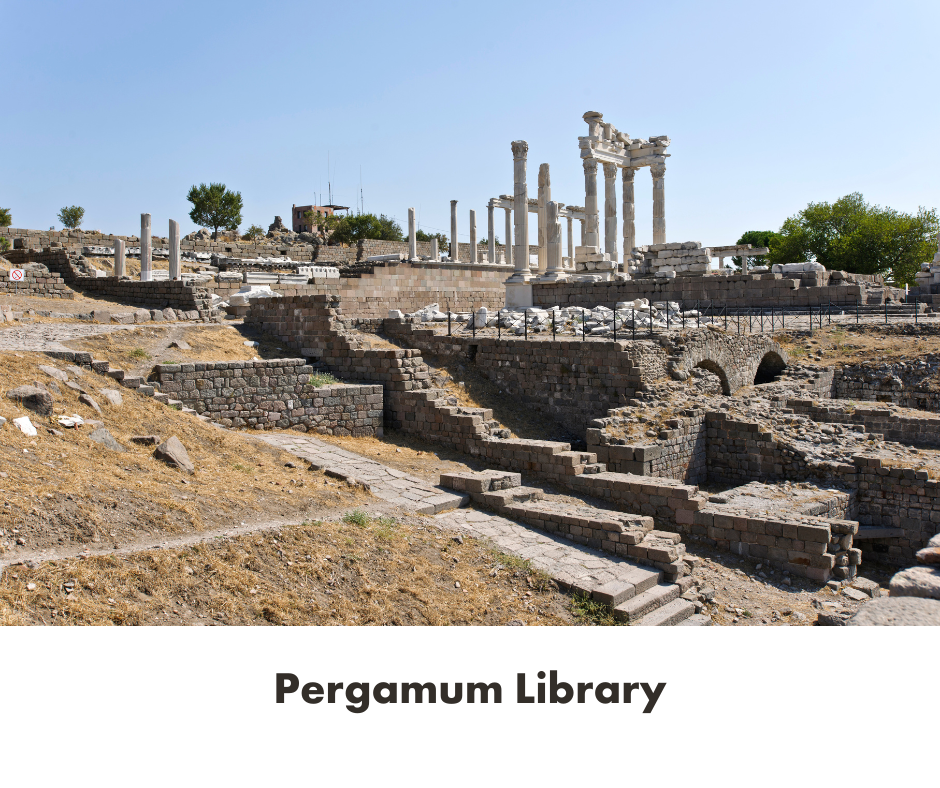Libraries have been closely associated with human civilization and culture for thousands of years. Libraries have been an integral part of human society since the dawn of civilization. The brightest aspect of human civilization and culture is the accumulation of human memory. Over the ages, the need to preserve these memories, experiences, fruits of feelings, moments of understanding, and creative works for the future generations has been felt. The Pergamum Library is a shining example of the many libraries that were created in ancient times by utilizing this feeling. The Pergamum Library has opened the door to various kinds of knowledge from the present to the future.

Origin of the Pergamum Library:
Etylus, one of the kings of the Greek emperor Alexander, came to power in Asia Minor in 241 BC. King Etylus I established the library in Pergamum, the capital of Asia Minor. After the death of Etylus, his successor, King Eumenes II, greatly improved the library. He built a new building for the library and sent people from different countries to collect manuscripts. Soon the library became one of the institutions for the dissemination of knowledge as a special patron of art and literature. But it faced problems with the material for writing books.
Writing materials of the Pergamum Library:
Papyrus was very popular as a writing material at that time. This papyrus was produced in the area along the Nile River in Egypt. King Eumenes II sent a letter to Ptolemy II Philadelphus asking for permission to import writing materials. But he refused to export papyrus to the Egyptian king Ptolemy because he did not want a library to be built on the same scale as Alexander’s.
Eumenes II was worried. But he was not upset. On the contrary, he did not stop working. He ordered the production of high-quality writing materials in Asia Minor, such as parchment made of animal skin and vellum made of bat skin. Later, under his orders, parchment and vellum began to be used as writing materials in Asia Minor. As a result, the collection of the Pergamum Library was made of parchment and vellum. As a result, the Pergamum Library quickly became prosperous.
Collection of the Pergamum Library:
For the collection of the Pergamum Library, literature was purchased and copied from different parts of Greece. Scribes were sent abroad to collect copies of manuscripts. During the reign of King Eumenes II, the library became even richer in terms of collection. According to the biographer Plutarch (55-120), the collection of this library at its peak was more than 200,000. According to some, its collection was as high as 160,000. It can be said that the entire knowledge of the world at that time was collected in it.
The main reading room, which was 44.5 ft × 50 ft (13.6 m × 15.2 m) and had numerous shelves, was the largest of the library’s four rooms.In an early attempt at library preservation, an empty space of about 50 cm (20 in) was left between the outer walls and the shelves to allow for air circulation. This was done with the intention of preventing the library from becoming too humid in the warm Anatolian climate. A 3 m (9.8 ft) statue of the Greek goddess Athena, modeled after her statue in the Parthenon, stood in the main reading room.
Library Collection Arrangement System
The collections of the Pergamum Library were arranged by subject and an index was prepared for each book. It can be assumed that this arrangement system was acceptable to all classes of writers. Books could be selected on the basis of the arrangement system and indexing. In this, the collection of the Pergamum Library was used well.
The Extinction of the Pergamum Library:
Rise and fall are not new or unusual events in history. Likewise, the prosperous Pergamum Library did not last long. In 133 BC, the Roman army conquered Pergamum and plundered all the materials of this library. Some speculate that Mark Antony (83-30 BC) plundered the Pergamum Library and took its two hundred thousand collections to Alexander and presented them to the then Queen of Egypt, Cypria (69-30 BC). And this collection was added to the collection of Alexander. Many also speculate that the books received as gifts to Kiopetra were added to the library adjacent to the Seraphim Temple. The valuable collection of the Pergamum Library was included in the Seraphim Museum, the Seraphim Library, and the Caesarean Library, and the famous Pergamum Library was destroyed.



